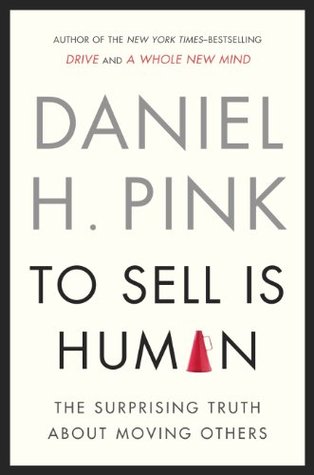More on this book
Community
Kindle Notes & Highlights
To sell well is to convince someone else to part with resources—not to deprive that person, but to leave him better off in the end.
“The challenge,” says Ferlazzo, “is that to move people a large distance and for the long term, we have to create the conditions where they can move themselves.”
This principle of moving others relies on a different set of capabilities—in
“It’s about leading with my ears instead of my mouth,” Ferlazzo says. “It means trying to elicit from people what their goals are for themselves and having the flexibility to frame what we do in that context.”
“We need to take a step back and bring [patients] on board,” she told me. “People usually know themselves way better than I do.” So now, in order to move people to move themselves, she tells them, “I need your expertise.” Patients heal faster and better when they’re part of the moving process.
To her the ideal salespeople are those who ask themselves, “What decision would I make if that were my own mom sitting there trying to get service or buy a car?”
Attunement is the ability to bring one’s actions and outlook into harmony with other people and with the context you’re in.
the ability to move people now depends on power’s inverse: understanding another person’s perspective, getting inside his head, and seeing the world through his eyes.
introverts are “geared to inspect,” while extraverts are “geared to respond.”35 Selling of any sort—whether traditional sales or non-sales selling—requires a delicate balance of inspecting and responding. Ambiverts can find that balance.
How to stay afloat amid that ocean of rejection is the second essential quality in moving others. I call this quality “buoyancy.”
Bob’s self-talk is neither positive nor declarative. Instead, to move himself and his team, he asks a question: Can we fix it?
the most effective self-talk of all doesn’t merely shift emotions. It shifts linguistic categories. It moves from making statements to asking questions.
Those who approached a task with Bob-the-Builder-style questioning self-talk outperformed those who employed the more conventional juice-myself-up declarative self-talk.
Once positive emotions outnumbered negative emotions by 3 to 1—that is, for every three instances of feeling gratitude, interest, or contentment, they experienced only one instance of anger, guilt, or embarrassment—people generally flourished.
The more you explain bad events as temporary, specific, and external, the more likely you are to persist even in the face of adversity.
“To people estranged from their future selves, saving is like a choice between spending money today and giving it to a stranger years from now.”6
“It is in fact the discovery and creation of problems rather than any superior knowledge, technical skill, or craftsmanship that often sets the creative person apart from others in his field.”8
First, in the past, the best salespeople were adept at accessing information. Today, they must be skilled at curating it—sorting through the massive troves of data and presenting to others the most relevant and clarifying pieces.
People often find potential more interesting than accomplishment because it’s more uncertain, the researchers argue.
Clarity on how to think without clarity on how to act can leave people unmoved.
Question 1. “On a scale of 1 to 10, with 1 meaning ‘not the least bit ready’ and 10 meaning ‘totally ready,’ how ready are you to study?” After she offers her answer, move to: Question 2. “Why didn’t you pick a lower number?”
The purpose of a pitch isn’t necessarily to move others immediately to adopt your idea. The purpose is to offer something so compelling that it begins a conversation, brings the other person in as a participant, and eventually arrives at an outcome that appeals to both of you.
By making people work just a little harder, question pitches prompt people to come up with their own reasons for agreeing (or not). And when people summon their own reasons for believing something, they endorse the belief more strongly and become more likely to act on it.
every Pixar film shares the same narrative DNA, a deep structure of storytelling that involves six sequential sentences: Once upon a time ______________________________. Every day, _______________. One day _________________________. Because of that, ___________________. Because of that, _______________________. Until finally ___________________.
“Never argue,” he wrote. “To win an argument is to lose a sale.”11
If you train your ears to hear offers, if you respond to others with “Yes and,” and if you always try to make your counterpart look good, possibilities will emerge.
In both traditional sales and non-sales selling, we do better when we move beyond solving a puzzle to serving a person.
“The best test, and the most difficult to administer, is this: Do those served grow as persons? Do they, while being served, become healthier, wiser, freer, more autonomous, more likely themselves to become servants?”21
be sure you can answer the two questions at the core of genuine service. If the person you’re selling to agrees to buy, will his or her life improve? When your interaction is over, will the world be a better place than when you began?


